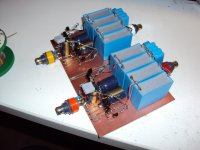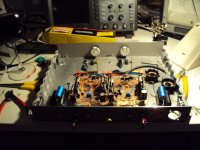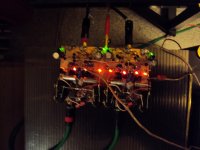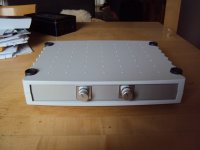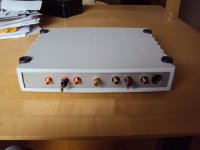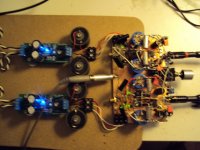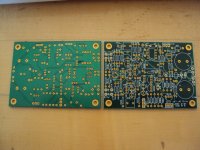I have now put the FRD data i collected of my Lyra Titan i in the Triplanar arm on the
Spiral Grove SG 1 into a 10dB/decade anti pink filter. Two things stand out. There is a very slight bump at around 10kHz and you see my particular low frequency response.
The arm is too heavy, i know and i will soon get the Schöder Artemis and the Spiral Grove Centroid that are both optimised for the Titan ( not only ). On the other hand the system sounds great. My subwoofer is mono and it has a steep subsonic filter under 16Hz. That both helps to avoid bottoming and in praxis the movement of the 4 30cm cones is well controled. You see now the arm-cartridge resonance at 6 Hz with +6dB. That was more like +9dB before but i use a first order subsonic filter at the moment under 20Hz so there is some supression from this filter. I whould not recommend a steeper filter in that case. The problem is mechanical and any steeper filter then the soft one i am using took a lot of emotion and fun out of the system.
So whats up next ? As you know i am now investigating PSUs and made a decission to go with shunt regulators with CCS. The Salas Hypnotize sounds so far the best and that is only the most simple implementation. What it consistently brought was a more quiet stage ( soundstage and phonostage ) much deeper and controlled bass with a lot of "sock" and heft and much better transparency with a deeper and better focussed picture. I have also ideas how to adopt Salas regulators better to the needs of my stages but first i will try his sense-force technology buy building the V1.2.
The next project then is to bring into cronological order the stages that have survived scrutinity, are already on PCB or even have being build by others like Masags FF2010 Linestage or the Discrete INA with Layout and Cabinet by Ward Maas of Pilgham Audio as discribes in Jan Diddens Linear 0. Since i have Salas regulators i have no desire any more to go the Bipolar-Transimpedance road. The stages i made sound great and i solved the DC offset problem satisfactory but the raw energy they have and that attracted me so much is also present in the newer Transconductance stages. When this compilation will be done i hope you have a better overview and understanding of the design process that looked a bit chaotic at times but all this, failure included was necessary to reach the high plateau i am now comfortably standing on. Noise, distortion and any kind of equalsation is simply not a challenge any more for me. Enyoy !
Spiral Grove SG 1 into a 10dB/decade anti pink filter. Two things stand out. There is a very slight bump at around 10kHz and you see my particular low frequency response.
The arm is too heavy, i know and i will soon get the Schöder Artemis and the Spiral Grove Centroid that are both optimised for the Titan ( not only ). On the other hand the system sounds great. My subwoofer is mono and it has a steep subsonic filter under 16Hz. That both helps to avoid bottoming and in praxis the movement of the 4 30cm cones is well controled. You see now the arm-cartridge resonance at 6 Hz with +6dB. That was more like +9dB before but i use a first order subsonic filter at the moment under 20Hz so there is some supression from this filter. I whould not recommend a steeper filter in that case. The problem is mechanical and any steeper filter then the soft one i am using took a lot of emotion and fun out of the system.
So whats up next ? As you know i am now investigating PSUs and made a decission to go with shunt regulators with CCS. The Salas Hypnotize sounds so far the best and that is only the most simple implementation. What it consistently brought was a more quiet stage ( soundstage and phonostage ) much deeper and controlled bass with a lot of "sock" and heft and much better transparency with a deeper and better focussed picture. I have also ideas how to adopt Salas regulators better to the needs of my stages but first i will try his sense-force technology buy building the V1.2.
The next project then is to bring into cronological order the stages that have survived scrutinity, are already on PCB or even have being build by others like Masags FF2010 Linestage or the Discrete INA with Layout and Cabinet by Ward Maas of Pilgham Audio as discribes in Jan Diddens Linear 0. Since i have Salas regulators i have no desire any more to go the Bipolar-Transimpedance road. The stages i made sound great and i solved the DC offset problem satisfactory but the raw energy they have and that attracted me so much is also present in the newer Transconductance stages. When this compilation will be done i hope you have a better overview and understanding of the design process that looked a bit chaotic at times but all this, failure included was necessary to reach the high plateau i am now comfortably standing on. Noise, distortion and any kind of equalsation is simply not a challenge any more for me. Enyoy !
Attachments
This oneWhich versions exactly?
and the one Salas quoted some time ago. I also made a version with a 9V batterie for the first stage. A bad idea, because the sweet spot wanderd away with the batterie in use within minutes.
Rüdiger
i promissed to bring my work into cronological order. First i studied Transimpedance MC input stages. They are usually build by using BJT transistors at the input in common base arangement, that means that the signal is coupled into the emitter of the BJT and not into the base as usual. This has advantages and disadvantages. Advantages are tremendoes speed ( a modern BJT in common base easily goes up to 5Mhz because the miller capacitance between base and collector is not amplified by the gain ) and a certain range of automatic gain matching because the gain of that stage is dependend on the impedance of the used MC cartridge. A cart with low impedance gets amplfied more and a cart with higher impedance that usually also has a higher voltage ouput gets amplified less. Usullay a Transimpedance stage is set up with a fixed ( low ) input impedance that makes experiments with loading unnecessary. The main disadvantage is, especially in a parallel symmetric circuit ( that i prefer beacuse of less noise and cancelation of second harmonic ) that considerable DC offset can be present in the cartridge because Ube voltage in NPN and PNP transistors is not similiar and considerable current flows though the emitters. A probelm can be radio demodulation and some carts do not sound right when connected to such a circuit because they sound overdamped. Usually a cartridge with low impedance is more happy with this circuit and i found no sound probblems with my collection of Lyra carts that have around 6 Ohm. Some designers claim less noise in such a circuit but i did not find that this is true in praxis and the literature sais that noise in a common base stage is the same then noise in a common emmitter stage provided the gain and the idlle current is the same. i looked over 6 month into improving circuits like that because i got good sound very quick. Usually the sound is dramatic, dynamic and very robust. Quite a shock when you are used to the typical IC Opamp input stage. I whould like to recommend two circuits for DIY. One is the Rosi and one is the Nobrainer i show here with and without the 75uSec timeconstant inplemented also in Transimpedance mode, thus converting a modulated current into a modulated voltage. The cuircuit use two different methods to avoid DC in the cart. The Rosi uses a floating supply so there is no current flowing in the ground and the Nobrainer uses Offset Cancelation with a trimmer. In the Nobarainer Offset has to be set with the cart connected or a similar resistor as dummy because before cancelation there is an emitter current flowing that produces an offset that is dependent on loading of the source resistor in this case the DC resistance of the used cart. I came up with a third method to cancel Offset that is even more elaborate but at that point my Fet stages had gotten so good in sound, also in terms of dynamic punsh that i saw no reason to walk that road any further. So here come the schematics. One little thing : Bias in the Nobbrainer is adjustable over a very wide range so you can experiment with different transistors and also you have some control over the input impedance. Raising the iddle current lowers the input impedance. You can also use several BJTs in parallel like in the Rosi. The output transistors in the Rosi are BC516/517 darlingtons for least distortion but you can use high Hfe transistors like BC550C/560C with very good results too.
The Rosi is simply an adoption of the Rositter circuit shown in AudioXpress. I used better parts like RIFA polypropylen caps for coupling instead of elcaps and redesigned for easier to buy transistors. 2N4401/4403, BC550C,560C and 2SA1015,2SC1815 and a host of others work well. I use the Faulkner circuit for noise reduction and i put in emitter resistors for a degree of current feedback that helps matching. Those resistors are not absoutely necessary when you do not like them in the signal path. The Nobrainer is designed completely by me and Holger Barske will put the circuit on a PCB and present it in Klang&Ton. See my prototype on Holgers website.
The Rosi is simply an adoption of the Rositter circuit shown in AudioXpress. I used better parts like RIFA polypropylen caps for coupling instead of elcaps and redesigned for easier to buy transistors. 2N4401/4403, BC550C,560C and 2SA1015,2SC1815 and a host of others work well. I use the Faulkner circuit for noise reduction and i put in emitter resistors for a degree of current feedback that helps matching. Those resistors are not absoutely necessary when you do not like them in the signal path. The Nobrainer is designed completely by me and Holger Barske will put the circuit on a PCB and present it in Klang&Ton. See my prototype on Holgers website.
Attachments
Parallel to Transimpedance circuits i looked into Fet inputs and the 3 circuits i recommend are the MPP Frickelfest also known as the MPP Nova, the MPP Nova with Transimpedance RIAA and finally the MPP Tanskonductance-Transimpedance that is also use in modified Form in the L`Art du Son Phonostage.
Attachments
The L´Art du Son has 16 different equalisation programms that can be programmed to any kind of shape also historical with shelf or only one ore two breakpoints. It can be programmed to be without equalisation over a wide gain range so you can use it as a linear Pre-Pre too. It can handle MC, High Output MC and MM and the input can have any value of capacitance and resistance. The standart stage comes with 6 colour coded load modules that have 118 Ohm white, 300 Ohm blue, 300 Ohm plus 2nF green, 470 Ohm red, 1kOhm yellow, 1kOhm plus 10nF black. I worked with Martina Schöner over one year on the correct time constants and the math and choice of components too me 6 month. See how it looks, still without lettering and label. No Load module is 56kOhm 100pF.
Attachments
Sam, this list will go on but as Rüdiger found, the Trasconductance-Transimpedance is the most recent design and has a very clean signal path and the best sound. Wait some days and i will show my latest open loop buffer that has not the problem of the overshot of the modified JLH buffer, is even a bit faster and can swing 70mA in class A. First prototypes put behind my Hoerwege Pioneer player gave such a boost in realism that i was seriously surprised. I am waiting for low noise voltage referesences and they should be there is some days. I will post a conceptual drawing in the next 30 minutes.
It depends on the Gm of the input stage and the impedance of the RIAA components.
I usually go for a gain of ca.60dB but that can easily being modified. For example double the values of the resistors in the RIAA and halve the values of the caps and you get 6dB more
but overload margin goes down and distortion goes up.
You get also 6dB more gain and 3dB less noise without affecting distortion by using 4 plus 4 input Fets and that is the version i am working on. I expect to be ready in the next 2 weks.
Now here comes the JG Open Loop Buffer. Ones i had the concept it worked in two hours but optimisation has taken me the best of two weeks.
I usually go for a gain of ca.60dB but that can easily being modified. For example double the values of the resistors in the RIAA and halve the values of the caps and you get 6dB more
but overload margin goes down and distortion goes up.
You get also 6dB more gain and 3dB less noise without affecting distortion by using 4 plus 4 input Fets and that is the version i am working on. I expect to be ready in the next 2 weks.
Now here comes the JG Open Loop Buffer. Ones i had the concept it worked in two hours but optimisation has taken me the best of two weeks.
